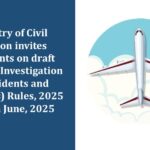After continuous deliberations, the Director General of Civil Aviation (“Ministry/DGCA”) has finally announced its policy for remotely piloted aircraft or drones. The efforts of the Ministry to establish legal obligations that would govern the commercial and civil use of drones have been manifested in the form of the Civil Aviation Requirements (CAR). On August 27, 2018, the Ministry has issued Civil Aviation Requirements under Rule 15A and Rule 133A of the Aircraft Rule, 1937 for the civil use of Remotely Piloted Aircraft System (RPAS).
What is a Remotely Piloted Aircraft (RPA)?
RPA is an unmanned aircraft, which is piloted from a remote pilot station.
What is an Unmanned Aircraft (UA)?
An aircraft, which is intended to operate with no pilot on board.
Applicability of the CAR and compliance coverage:
The CAR primarily lays down requirements for obtaining Unique Identification Number (UIN), Unmanned Aircraft Operator Permit (UAOP) and other operational requirements for Civil Remotely Piloted Aircraft System (RPAS). The CAR is applicable to Civil RPAS, which are remotely piloted from a Remote Pilot Station and it categorizes RPA on the basis of Maximum All-Up-Weight (including
payload) into Nano, Micro, Small, Medium and Large.
Effective Date of this CAR:
1st December, 2018.
Key Highlights:
- Separate application procedures have been provided for RPA being imported to India and those purchased locally. In both the processes, an Equipment Type Approval (ETA) from WPC Wing, Department of Telecommunication for operating in de-licensed frequency band(s) is a must.
- Civil RPA except those indicated below, shall require Unique Identification Number (UIN) from DGCA.
i. RPA in Nano category intended to fly upto 50 feet (15 m) Above Ground Level (“AGL”) in uncontrolled airspace/ enclosed premises for commercial / recreational / R&D purposes are exempted from obtaining UIN.
ii. RPAs owned / operated by National Technical Research Organization, Aviation Research Centre and Central Intelligence Agencies are also exempted from obtaining UIN.
- Civil RPA operators are required to obtain an Unmanned Aircraft Operator Permit (UAOP) from DGCA. Following RPA is exempted from obtaining this permit:
- Nano RPA operating below 50 feet (15 m) AGL in uncontrolled airspace / enclosed premises.
- Micro RPA operating below 200 feet (60 m) AGL in uncontrolled airspace / enclosed premises. However, the user shall intimate to local police office 24 hours prior to conduct of actual operations.
- RPA owned and operated by the agencies as indicated in point 2(ii) above. However, the agency shall intimate local police office and concerned Air Traffic Service Units prior to conduct of actual operations.
- Comprehensive Security / Safety Requirements, Equipment Requirements and Maintenance Requirements for RPAS have been laid down along with the minimum standard for manufacturing of RPAS. The operator shall be responsible for the safe custody, security and access control of the RPAS. In case of loss of RPA, the operator shall report immediately to the local police office, Bureau of Civil Aviation Security and DGCA.
[Note: Operator means a person, organization or enterprise engaged in or offering to engage in an aircraft operation.]
- The CAR lays down following operating restrictions with respect to the RPA. No RPA shall be flown:
- Within a distance of 5 km from the perimeter of airports at Mumbai, Delhi, Chennai, Kolkata, Bengaluru and Hyderabad;
- Within a distance of 3 km from the perimeter of any civil, private or defence airports, other than those mentioned in point (i) above;
- Above the Obstacle Limitation Surfaces (OLS) or PANS-OPS surfaces, whichever is lower, of an operational aerodrome, specified in Ministry of Civil Aviation (Height Restrictions for Safeguarding of Aircraft Operations) Rules, 2015;
- Within permanent or temporary Prohibited, Restricted and Danger Areas including Temporary Reserved Areas, and Temporary Segregated Areas, as notified in Aeronautical Information Publication;
- Within 25km from international border which includes Line of Control (LoC), Line of Actual Control (LAC) and Actual Ground Position Line (AGPL);
- Beyond 500 m (horizontal) into sea from coast line provided the location of ground station is on fixed platform over land;
- Within 3 km from perimeter of military installations/ facilities/ where military activities/ exercises are being carried out unless clearance is obtained from the local military installation/facility;
- Within 5 km radius from Vijay Chowk in Delhi. However, this is subject to any additional conditions/ restrictions imposed by local law enforcement agencies/authorities in view of the security.
- Within 2 km from perimeter of strategic locations/ vital installations notified by Ministry of Home Affairs unless clearance is obtained from MHA;
- Within 3 km from radius of State Secretariat Complex in State Capitals;
- From a mobile platform such as a moving vehicle, ship or aircraft;
- Over eco-sensitive zones around National Parks and Wildlife Sanctuaries notified by Ministry of Environment, Forests and Climate Change without prior permission.
- In case of violation of provisions of this CAR/ approved operating conditions, the UIN/ UAOP issued by DGCA shall be suspended/ cancelled.
The Regulations issued by the DGCA are first of its kind and will enable the safe, commercial usage of drones.
Source: Directorate General of Civil Aviation




